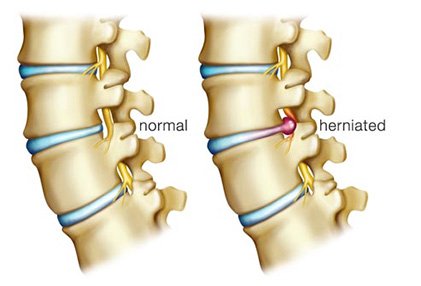 20th Oct 2015
20th Oct 2015
How To Treat Herniated Discs with Physical Therapy
I meet people all the time who complain of low back pain as a result of herniated disc. What they don’t know is physical therapy can give the herniated disc time to heal and that the pain they experience is not something they have to live with. As a matter of fact, physical therapy will not only reduce pain, allow the herniation to heal, but also help patient’s get back to normal function.
What is a herniated disc?
The spine is made up of connected bones called vertebrae. The disc holds the vertebras next to each other and is a combination of strong connective tissues. The disc is made of a strong outer layer, the "annulus fibrosus", and a gel-like center called the "nucleus pulposus." The disc may start to lose water content, making the disc less effective as a cushion. This may cause a displacement of the disc’s center (called a herniation) through a crack in the outer layer. Most disc herniations occur in the bottom two discs of the lumbar spine.

A herniated lumbar disc can press on the nerves in the spine and may cause pain, numbness, tingling or weakness of the leg called "sciatica."
Physical Therapy Modalities for Herniated Discs
- Kinesio Tape: Kinesio Tape applied to the lumbar area will help increase blood flow and reduce pressure on the nerves which will help to decrease pain and inflammation. Also, Kinesio Tape can relieve pain localized at the spine on particular vertebrae as well as any radiating pain.
- Ultrasound & Electrotherapy: Used together Ultrasound & Electrotherapy machines help increase blood flow and reduce pain. The vibrations created through the soft tissue increase the heat within the tissue, which increases blood flow and reduces pain. The heat produced also relaxes muscles and improves the ability of soft tissues to stretch. This is extremely helpful for compressive pain disorders like sciatica and herniated discs, where the pain is the result of pressure placed on spinal nerves.
- Whirlpool therapy: As a result of pain caused by herniated discs, the muscles attached and surrounding the herniation tend to overwork and tighten. Whirlpool therapy is a gentle modality that not only relieves pain, but also relaxes the muscles of the back.
- Low Level Laser Therapy: A recent study published in the Journal of Manipulative and Physiological Therapies examined the effectiveness of laser therapy in treating lumbar disc herniations and found that "low power laser therapy is effective in the treatment of patients with acute lumbar disc herniations."
- Cold Therapy: The inflammation along the spinal walls as a result of a herniated disc press on the nerve in the spinal canal, which causes pain. Cold compression therapy is effective for pain relief because it constricts the veins along the spine, slowing circulation and reducing inflammation.
Our propensity towards sedentary work and home-lives will only increase a person’s chance of developing a disc herniation. According to statistics, 1/3 of Americans over the age of 20 show signs of herniated discs. With herniated discs, it’s important to consider non-surgical options first. Luckily, physical therapy offers many tools to help patients suffering from herniated discs, so they can continue to function in their day-to-day lives pain-free.





